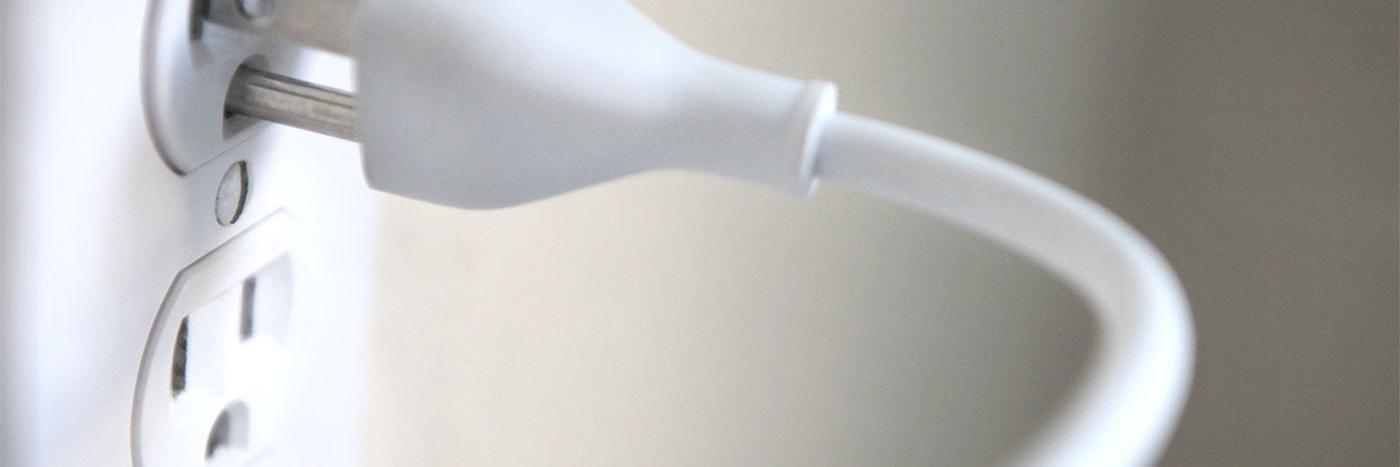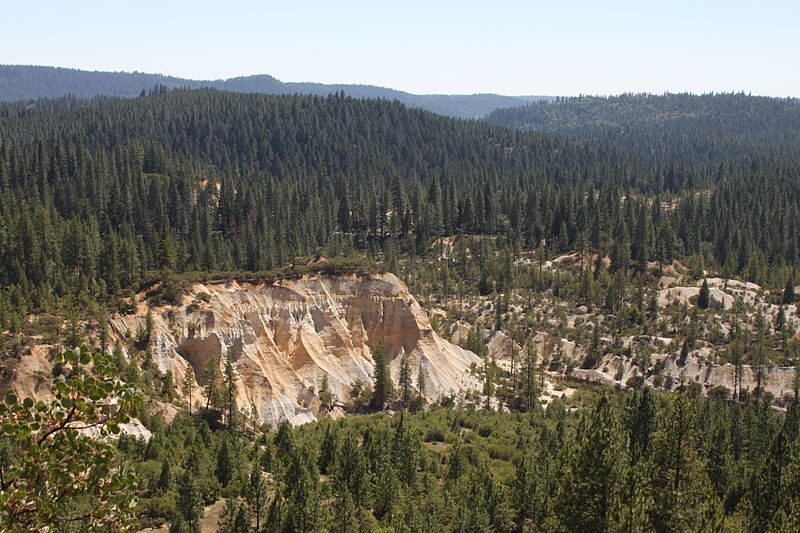Berkeley/UCLA Law report discusses policy solutions to boost energy retrofits. Free webinar tomorrow (Thursday), June 20th at 10am features expert panel to discuss top findings.
As California moves aggressively to reduce greenhouse gas emissions from buildings, will the state leave behind its low-income residents? Many of these residents — 40% of the state’s population — live in multifamily housing units and apartments, where they have limited access to in-home retrofits that could save them on their energy bills and reduce overall emissions. These retrofits require upfront capital that low-income tenants may lack, as well as approval and awareness by landlords who may be unwilling or unable to support them.

To identify ways to help solve this thorny problem, UC Berkeley School of Law’s Center for Law, Energy & the Environment (CLEE) and UCLA School of Law’s Emmett Institute on Climate Change and the Environment are today releasing a new report, Low Income, High Efficiency. The report offers policy solutions to increase access to energy efficiency incentives and unlock environmental, financial, and quality-of-life benefits for owners and residents alike, including:
- Creating a single, statewide “one-stop shop” efficiency program administrator to comprehensively manage incentives and offer users a single point of access.
- Expanding innovative financing mechanisms such as “pay as you save” and third-party “energy budget” arrangements that take advantage of residents’ utility bills and private capital.
- Creating a comprehensive database to help prioritize retrofit projects and support energy data benchmarking and analysis efforts.
The report also contains numerous additional solutions for policy makers to consider, as well as five case studies focusing on California low-income multifamily properties that recently undertook efficiency projects, in order to yield valuable lessons learned. The findings resulted from two stakeholder convenings with experts across state energy agencies, local governments, housing owner/developers, environmental and housing advocates, and efficiency program implementers and contractors.
California has committed to reducing greenhouse gas emissions 40 percent below 1990 levels by 2030 and doubling the energy efficiency of buildings by that year, but the state will need significant improvements in the energy performance of existing buildings to achieve these goals. While the state has adopted aggressive standards for efficiency in new construction, owners and residents of existing low-income multifamily buildings face a particularly daunting set of barriers, including limited access to capital, complex financing arrangements and restrictions, and competing renovation needs. Low Income, High Efficiency offers a suite of policy innovations and proposals to address these challenges.
To discuss the report’s findings, CLEE and the Emmett Institute will host a free webinar on Thursday, June 20 (tomorrow) at 10am with an expert panel, including:
- California Energy Commissioner Andrew McAllister
- Peter Armstrong of Wakeland Housing
- Martha Campbell of the Rocky Mountain Institute
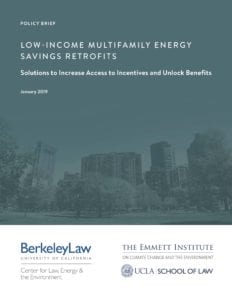 California needs to improve the energy performance of existing buildings in order to meet efficiency and greenhouse gas emission goals, as well as save property owners money on their utility bills. But owners of low-income, multifamily buildings face significant obstacles, including difficult access to capital, complex financing arrangements, and competing renovation needs. Furthermore, residents in these buildings experience a “split incentive” problem that limits owners’ financial interest in upgrades that primarily reduce residents’ utility bills.
California needs to improve the energy performance of existing buildings in order to meet efficiency and greenhouse gas emission goals, as well as save property owners money on their utility bills. But owners of low-income, multifamily buildings face significant obstacles, including difficult access to capital, complex financing arrangements, and competing renovation needs. Furthermore, residents in these buildings experience a “split incentive” problem that limits owners’ financial interest in upgrades that primarily reduce residents’ utility bills.
To address these challenges, UC Berkeley and UCLA Schools of Law are issuing today a new policy brief based on two stakeholder convenings that identify policy solutions to address key barriers, increase access to energy efficiency incentives, and unlock environmental, financial, and quality-of-life benefits for owners and residents alike. Among the solutions:
- The Legislature or Public Utilities Commission could create a single, statewide “one-stop shop” efficiency program administrator for users to obtain information about available programs, determine applicability, submit all filings, manage participation, and receive technical assistance.
- The Legislature could create a long-term fund to support the one-stop shop Administrator and subsidize advanced efficiency measures, allowing owner/developers to plan efficiency projects in line with their long-term obligations.
- State energy regulators could create a comprehensive database to help prioritize retrofit projects and support Energy Commission energy data benchmarking and analysis efforts under AB 802.
You can access the policy brief here. A full-length report detailing the comprehensive findings will be released later this year.
The new federal spending bill that just became law represents a big win for transit, clean technology and energy efficiency. Despite efforts by the administration to gut funding in all of these areas, a bipartisan majority in congress resisted.
Curbed covered the increased spending for transit:
The bill, which covers spending through the end of September, includes significant increases in transit funding. The Community Development Block Grant program, which many local governments have used to fund streetscaping, cycling, and pedestrian-friendly projects, would receive a significant boost, rising to $3.3 billion from the $3 billion allocated in 2017. Initially, President Trump’s budget called for eliminating the program.
In addition, the bill includes more money for Capital Investment Grants, which help pay for transit projects, increasing spending from $2.4 to $2.6 billion, and would allocate $1.5 billion for the TIGER Grant program, tripling the $500 million spent on the program in 2017. This Obama-era program has been a key tool used by state and local governments to fund new rail and transit expansions.
Notably, even Amtrak funding increased under the package.
Meanwhile, some of the most important research and clean energy programs at the Department of Energy were bolstered, as E&E reported [paywalled]:
Instead of eliminating the Advanced Research Projects Agency-Energy, DOE’s innovation arm, the package increases funding to a record level of $353 million. The Weatherization Assistance Program, which Trump also wanted to kill, would get a more than $20 million boost to $248 million. The deal keeps state energy grants and the Title 17 Innovative Technology Loan Guarantee Program intact.
It also would increase funding for the Office of Energy Efficiency and Renewable Energy, which Trump wanted to slash by more than half.
This is all good news, and it points to the bipartisan support for these key components of our climate mitigation strategies. There’s still a larger issue about the availability of long-term funding for these programs, given the massive deficits the federal government is running, particularly with the budget-busting tax cut passed last December. But for now, these programs are safe and even stronger, in a rebuke to the administration and transit and clean tech opponents.
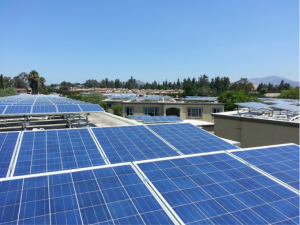 A common knock on California’s climate programs is that they often end up disproportionately benefiting the wealthy. From cash rebates for Tesla drivers to lower electricity rates for single-family homeowners with solar panels, there was some truth to the complaint.
A common knock on California’s climate programs is that they often end up disproportionately benefiting the wealthy. From cash rebates for Tesla drivers to lower electricity rates for single-family homeowners with solar panels, there was some truth to the complaint.
But in the last few years, the legislature and other state leaders have made efforts to expand the benefits of these programs to low-income Californians. Rebates for electric vehicles, for example, are now means-tested and not available to high-income residents, and at least 25 percent of cap-and-trade auction proceeds must go to disadvantaged communities.
Now residential solar incentives are part of the mix, too. The California Public Utilities Commission just approved spending $1 billion in cap-and-trade dollars over the next 10 years on incentives for landlords to install rooftop solar panels on apartment buildings housing low-income residents. The San Jose Mercury News has more details.
Overall, the program seems like a smart investment, given that multifamily dwellers (especially of the low-income variety) are otherwise cut out of these opportunities if they don’t own their roofs. Politically it also gives more Californians a stake in the state’s climate programs, which helps build public support to keep the programs stable.
But it would be nice to see this program bundled with energy efficiency incentives. Just like solar is a tough nut to crack, given the split incentives among landlords who own the building and the tenants that pay the bills, so is energy efficiency work, which should be the first priority to save energy. Bundling efficiency incentives with solar could make landlords more open to doing this retrofit work, as well as making it more economically effective.
I’d also note that overall, California’s climate programs are benefiting the economy and creating jobs in some of our most disadvantaged regions, including the San Joaquin Valley and Inland Empire, as we studied in reports this year. And as wealthier residents purchased clean technologies like electric vehicles and solar panels when they were expensive in the early years of production, they’ve helped bring the costs down to the point where these technologies are now affordable to many millions of Californians.
But overall this solar incentive program is a good step in the right direction, and a harbinger of more climate programs to come that will benefit the state’s low-income residents.
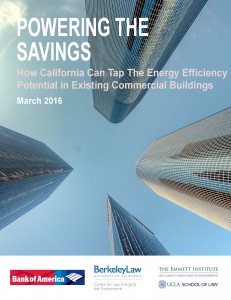 California has an aggressive goal to double the energy efficiency of existing buildings by 2030. The problem though is that building owners don’t seem very interested in having energy retrofit work done on their house or commercial property. We covered this subject in a recent Berkeley/UCLA Law report Powering the Savings, as well as in a September panel event at Berkeley Law.
California has an aggressive goal to double the energy efficiency of existing buildings by 2030. The problem though is that building owners don’t seem very interested in having energy retrofit work done on their house or commercial property. We covered this subject in a recent Berkeley/UCLA Law report Powering the Savings, as well as in a September panel event at Berkeley Law.
A reporter from E&E News attended that event and interviewed a few of us afterwards. Her article (paywalled) described some of the challenges:
The price tag for California’s goal is extremely high. Retrofitting all owner-occupied housing units in California — half of all housing — would cost $180 billion, DeVries estimated. There have been about $4.5 billion worth of retrofits under PACE programs nationwide, mostly in California. “I don’t think we’re going to find the money here,” he said. “We’re going to have to find it elsewhere, which means Wall Street, which means securitizations.”
Wall Street has the appetite, according to DeVries. His company’s latest offering of $220 million in project-backed bonds saw four times more demand than the available supply. The problem is consumer demand. “You can have all the investor interest in the world, and it doesn’t matter one bit,” he said. “The chicken and the egg here — the demand has to come first.”
Figuring out easy, capital market-type financing could help drive this demand, as we’ve seen with rooftop solar. And finding ways to reach building owners during key moments is also important, like when they’re between tenants or when remodeling or appliance replacements are in the works. But at some point, the state may need to move toward mandatory retrofit requirements during times of change in ownership or tenancy, as other jurisdictions have done.
Without these steps, what should be one of the most cost-effective ways to fight climate change may continue to under-perform and under-deliver.
To make any lasting progress on climate change, we’re going to need to be a whole lot more efficient with the energy we produce. That means retrofitting existing inefficient buildings as much as possible to reduce waste.
 The dream would be to make a home or commercial building energy retrofit as easy and scalable as rooftop solar has become. But so far nobody seems to have figured out how to do it. There are some promising options, which we explored in a recent policy report called Powering the Savings.
The dream would be to make a home or commercial building energy retrofit as easy and scalable as rooftop solar has become. But so far nobody seems to have figured out how to do it. There are some promising options, which we explored in a recent policy report called Powering the Savings.
But maybe the missing ingredient has been the insurance market. The idea is that if insurers are willing to back a home or business retrofit project, then financiers should be much more willing to bring Wall Street-type money to the effort on a mass scale. As PR Newswire reported:
Sealed, an energy software company that empowers homeowners to pay for home upgrades like insulation, air sealing, and smart thermostats with their energy savings, announced today the implementation of a residential energy efficiency insurance policy from The Hartford Steam Boiler Inspection and Insurance Company (HSB), part of Munich Re.
This innovative program insures the performance of Sealed’s proprietary energy analytics, which both removes energy savings performance risk from homes that finance energy efficiency improvements and increases the confidence of third party capital providers.
The key here is trusted and verifiable software that can measure actual energy saved via specific efficiency measures. With software improving to do just that, these kinds of financing arrangements will be just around the corner.
 Energy efficiency probably doesn’t sound too exciting to most people, but saving hundreds of dollars without having to do anything about it probably does. Not to mention reducing pollution and fiscal waste. And that is the legacy of Art Rosenfeld, who passed away last week at the age of 90.
Energy efficiency probably doesn’t sound too exciting to most people, but saving hundreds of dollars without having to do anything about it probably does. Not to mention reducing pollution and fiscal waste. And that is the legacy of Art Rosenfeld, who passed away last week at the age of 90.
Most people have probably never heard of him, but back in the 1970s Mr. Rosenfeld pioneered the idea of energy efficiency standards for new homes and appliances. These standards became law in California and have spread nationwide. As the San Francisco Chronicle obituary reads:
His quest for energy efficiencies led to breakthroughs in a host of areas that affect every person in California: buildings with low-energy electric lights, like compact fluorescent lamps or CFLs; kitchens with low-energy refrigerators; and glass windows that trap heat.
Economists have estimated that those efficiencies have saved Americans countless billions of dollars.
As he pursued his technical efforts, Mr. Rosenfeld also maintained a powerful public focus on persuading utilities and government policymakers that requiring energy-efficient power plants could not only save dollars but would also curb the greenhouse gas emissions that are warming the planet.
I never overlapped with him when he was based at UC Berkeley, but I had colleagues who worked with him and spoke reverently of him and his work. It’s rare to have one person so embody a major field like Rosenfeld did of energy efficiency. His contributions to the environment and all of our pocketbooks are enormous, and we would do well to continue carrying on his legacy and life’s work.
 Climate policies are under political attack, both in California and nationally. The common argument is that these policies hurt the economy and destroy jobs, particularly in disadvantaged communities.
Climate policies are under political attack, both in California and nationally. The common argument is that these policies hurt the economy and destroy jobs, particularly in disadvantaged communities.
To assess those claims, the Center for Law, Energy and the Environment (CLEE) at UC Berkeley Law and UC Berkeley’s Donald Vial Center on Employment in the Green Economy, working with the nonpartisan nonprofit Next 10, released today the first comprehensive cost/benefit study of climate policies in the San Joaquin Valley, one of California and the nation’s most economically and environmentally vulnerable regions.
The Economic Impacts of California’s Major Climate Programs On The San Joaquin Valley specifically looked at the impact of cap-and-trade, renewable energy, and energy efficiency programs in the eight-county region.
Why the Valley? Simply put, if climate policies can work in this region, they can work anywhere. In addition, the region’s elected leaders have asked questions about the impact of climate policies on their constituents, raising their concerns both in the state legislature and now nationally in the congress.
After examining the data and using advanced modeling software, we found that these three programs (among the most important in California’s suite of climate policies) brought over $13 billion in economic benefits to the Valley, mostly in renewable energy, and created over 31,000 jobs just in the renewable energy sector alone.
With the relatively new cap-and-trade program, we found that despite the compliance costs in the heavily industrial Valley, the benefits from state spending of the allowance auction proceeds outweighed those costs, particularly due to construction of high speed rail, which is funded in part with these funds. Furthermore, once the state disburses proceeds already collected from the auction, those benefits will increase greatly.
The overall benefits to the Valley are likely to continue and grow through 2030, as the state strives to meet its newly legislated climate goals for that year, via last year’s SB 32 (Pavley) and SB 350 (De Leon, 2015). Those efforts will require at least 50% renewables by 2030, a doubling of energy efficiency in existing buildings, and a more robust cap-and-trade program.
However, the benefits of cap-and-trade may cease if litigation over the auction mechanism (described by Ann Carlson at UCLA Law) is successful, as that mechanism allows the state to spend the proceeds that provide the benefits. Furthermore, federal action to undercut renewables and energy efficiency could also slow the gains.
Ultimately though, California is committed to its path and these programs through bipartisan legislation and regulations. Given the economic data we see in this study, its a path that the state should continue — and it can hopefully now inform federal debates about environmental policy and the need for job-producing programs.
You can access the full report via CLEE or Next 10’s websites, and check out partial media coverage in the Los Angeles Times, Central Valley Business Times, and Capitol Public Radio.
In the effort to reduce greenhouse gas emissions, glitzy technology like solar panels and electric vehicles get a lot of attention. But often times there are some simple and relatively cheap technologies that can make just as much difference, particularly when looking at the costs.
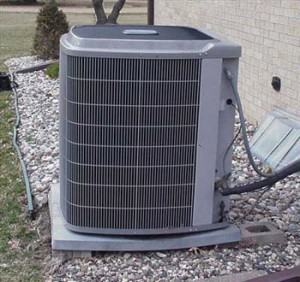 Energy efficiency measures are a great example. Conserving energy is just as powerful, if not more so, than buying emissions-free energy like solar power. But it’s much cheaper. Case in point: updating your cable box to take advantage of new efficiency features can save you a lot on your utility bill.
Energy efficiency measures are a great example. Conserving energy is just as powerful, if not more so, than buying emissions-free energy like solar power. But it’s much cheaper. Case in point: updating your cable box to take advantage of new efficiency features can save you a lot on your utility bill.
Now David Roberts at Vox.com flags another promising technology: the heat pump.
A heat pump is a “mechanical-compression cycle refrigeration system” that can serve as both a furnace and an air conditioner (indeed, many air conditioners are just one-way heat pumps). From manufacturer Trane:
Even in air that seems too cold, heat energy is present. When it’s cold outside a heat pump extracts this outside heat and transfers it inside. When it’s warm outside, it reverses directions and acts like an air conditioner, removing heat from your home.
Because it merely moves, rather than generates, heat, it is far more efficient than combustion furnaces.
They key feature for our purposes is that heat pumps run on electricity. When Siemens modeled shifting 80 percent of citywide heat consumption over from natural gas to electric heat pumps, emissions declined another 14 percent…
Switching natural gas appliances to electric will be critical in the long term to reducing emissions from buildings. Right now, most furnaces and ranges are natural gas powered, but heap pumps can make the transition to electric heating much easier. Then when you combine it with emissions-free electricity such as from solar power, you’ve suddenly got a major climate win.
My guess is that with the right policy-based incentives (rebates and cheap financing), we could greatly spur consumer adoption of these technologies and ultimately bring the price down as economies of scale kick in. It would be a big win for the climate and potentially a cost-effective use of our resources.


